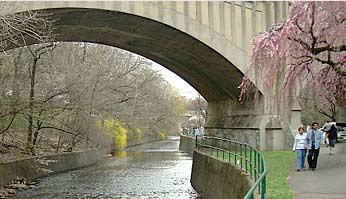BET Consultants
Fast Facts
- The premier consulting firm in New Jersey
- Geographical areas serviced: New Jersey, New York, and Pennsylvania
- M.B.E./D.B.E. Professional Services
- Mapping
- Surveying
- Engineering
| 
BRANCH BROOK PARK, ESSEX COUNTY, NEW JERSEY
CULTURAL RESOURCES SURVEY
(Owner: Essex County Department of Parks, Recreation, and Cultural Affairs)
|
 A Cultural Resources Survey was part of the services for the total redevelopment plan of Branch Brook Park, Essex County, New Jersey. A Cultural Resources Survey was part of the services for the total redevelopment plan of Branch Brook Park, Essex County, New Jersey.
The purpose of the survey was to assess the cultural resources potential of areas proposed for construction, to identify those areas where no impact on cultural resources is likely, and to make recommendations concerning cultural resources potentially eligible for the National Register of Historic Places. The study also served as a planning document presenting an assessment of cultural resources throughout the entire Branch Brook Park. Three categories of cultural resources were assessed:
- the park as an entity
- architectural properties within the park
- archeological remains within the park
Primary and secondary documentary materials were consulted in order to assess aspects of the natural and cultural environment needed to identify existing cultural resources, predict areas potentially containing archeological resources, and interpret cultural resources identified during the survey stages of the project.
The infield survey included an examination of both architectural and archeological properties within the project area.
The architectural survey focused upon any existing properties presently on the National Register of Historic Places. Also, all architectural properties within the park were visually examined for both their individual integrity and their integrity as part of Branch Brook Park.
The infield archeological survey focused primarily upon sites predicted as sensitive to archeological resources through the initial documentary survey. Where project construction actions were proposed to directly impact these sensitive sites, a subsurface testing program was designed to delineate any archeological resources potentially affected by the proposed actions.
- The roadways and drives, originally intended for horse and buggy traffic, were redesigned to safely accommodate today's motoring public. One of the most important components of the total planning and design of the park was the 4-mile road network. The Principals of BET Consultants were responsible for relocating sections of the existing roads and planning a new 600-foot entrance road. The final design called for 40-foot wide roads with bituminous concrete pavement. The 55 foot long reinforced concrete arch footbridge was designed.
- The stormwater system was improved on the basis of extensive rain/runoff and other hydraulic analyses. The original road system drained into the 30-acre lake, which resulted in reduced water quality and limited recreation use. The new design provides for storm water discharge into a storm sewer system, which bypasses the lake.
- The lake rehabilitation involved slope stabilization, which was achieved by sound and aesthetically-pleasing concrete grid blocks (grass pavers), which also enhanced the recreational use of the lake. The lake rehabilitation also included dredging and installation of lake aeration systems. Analysis of the spoil dredged from the lake disclosed the presence of toxic waste. Recommendations for the handling and safe disposal of the toxic waste represented an important part of this project.
CONSTRUCTION MANAGEMENT
The construction of the entire project was performed under nine (9) separate prime contracts. The Principals of BET Consultants managed the construction work. |
|
|
|